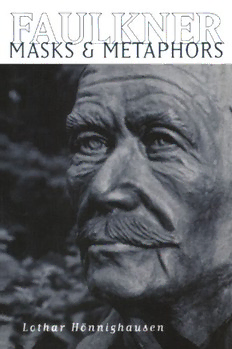
FAULKNER: masks and metaphors PDF
Preview FAULKNER: masks and metaphors
F A U L K N E R: M A S KS A ND M E T A P H O RS This page intentionally left blank Faulkner Masks and Metaphors Lothar Honnighausen University Press of Mississippi Jackson In the process of writing sections of this book, I have significantly revised some previously published materials. One part of chapter 4 has been adapted from The Artist and His Masks: William Faulkner's Metafiction, ed. Agostino Lombardo; two other sections are based on a paper presented at the Vienna session of the International Faulkner Symposium, which appeared in Faulkner, His Contemporaries, and His Posterity, ed. Waldemar Zacharasiewicz. Part of chapter 5 draws on sections one and three of my article "The Imagery in Faulkner's A Fable/' in Faulkner: After the Nobel Prize, ed. Michel Cresset and Kenzaburo Ohashi. The last section of chapter 7, in another form, was presented at the University of Mississippi Faulkner and Yoknapatawpha Conference (1986) and published in Faulkner and Race, ed. Doreen Fowler and Ann J. Abadie. Copyright © 1997 by University Press of Mississippi All rights reserved Manufactured in the United States of America Print-on-Demand Edition The paper in this book meets the guidelines for permanence and durability of the Committee on Production Guidelines for Book Longevity of the Council on Library Resources. Library of Congress Cataloging-in-Publication Data Honnighausen, Lothar. Faulkner : masks and metaphors / Lothar Honnighausen. p. cm. Includes bibliographical references (p. ) and index. ISBN 0-87805-998-9 (cloth : alk. paper) 1. Faulkner, William, 1897-1962—Style. 2. Metaphor. 3. Role playing in literature. 4. Disguise in literature. I. Title. PS3511.A86Z829 1997 813'.52—dc21 97-6952 CIP British Library Cataloging-in-Publication data available FOR MY F R I E N DS OF T HE I N T E R N A T I O N AL F A U L K N ER S Y M P O S I UM This page intentionally left blank CONTENTS Introduction ix Primary Texts: List of Abbreviations xiii Preludes 1. Role-Play in Photos, Letters, and Interviews 3 2. Masks and Metaphors: On Theory 56 Masks and Metaphors of the Artist 3. The Artist as Visionary and as "Craftsman": "Black Music/' "Carcassonne/' "Artist at Home/' Elmer, and Mosquitoes 79 4. The Artist as "Human Failure": Mosquitoes, Flags in the Dust, The Town, and As I Lay Dying 111 Metaphorizing and Role-Play in Narration and Reading 5. New Modes of Metaphor: The Sound and the Fury, Light in August, and A Fable 137 6. Metaphor and Narrative in Absalom, Absalom! 157 7. Faulkner and the Regionalist Context 183 8. Regionalism and Beyond: The Hamlet 223 Conclusion: Pastoral Portrait 263 Notes 279 Works Cited 289 Index 301 This page intentionally left blank What then is truth? A mobile army of metaphors, metonymies, and anthropomorphism. —Friedrich Nietzsche quoted in Jacques Derrida Part of the fun of writing is putting on masks. —Tom Whalen Introduction The pronouncement of the nineteenth century philosopher Friedrich Nietzsche as transmitted through the deconstructive spirit of Jacques Derrida and the casual remark of the contemporary American poet Tom Whalen on a writer's pleasure in role-playing mark the wide range of this book's theme. It contains cognitive, ethical, and aes- thetic aspects, centering on masks and metaphors and comprising the sociopsychic implications for Faulkner's readers of his personae and his imagery. Nietzsche's replacement of truth by metaphor accords well with his conviction that the modern artist can best be under- stood as a wearer of masks ("around every complex spirit a mask continually grows" [Beyond Good and Evil 69-70]).' Indeed, Nietz- sche's interrelated views on masks and metaphor constitute the threshold of my approach to Faulkner.2 The first part of the book, comprising chapters 1 and 2, is devoted to Faulkner's role-playing in his photos and interviews and to the theoretical grounding of the concepts of mask and metaphor. The second part (chapters 3 and 4) contains studies of specific masks and metaphors of the artist. Chapters 5-8, making up the third part, seek to utilize the aesthetics emerging in parts 1 and 2 by focusing on metaphoric strategies in Faulkner's major novels. The discussion in this third part proceeds from some specific aspects of the metaphoric- ity in The Sound and the Fury, Light in August, and A Fable to the center of the book, the more comprehensive studies of Absalom, Absalom! and particularly The Hamlet. The investigation of the interaction of the several modes of image making and image receiving, their psycho- analytic and sociopolitical, modernist and regionalist features, dem- onstrates that Faulkner's greatness lies as much in the creativeness of his metaphorics as in his narrative inventiveness.
